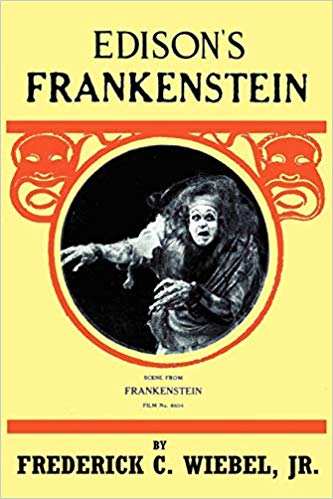 By FREDERICK C. WIEBEL, JR. (Bear Manor Media; 2010)
By FREDERICK C. WIEBEL, JR. (Bear Manor Media; 2010)
This book has some irritants but I treasure it nonetheless, and enthusiastically recommend it to anyone with an interest in the origins and evolution of horror cinema. It tells the story of Thomas Edison’s legendary 1910 adaptation of Mary Shelley’s FRANKENSTEIN, possibly the first true horror movie and one of most sought-after silent films of all time.
While many of the details of this FRANKENSTEIN’S production and reception have been lost to history, author Frederick C. Wiebel, Jr. gathers as much info as he possibly can from vintage advertisements, newspaper clippings, diary entries and so forth. This book doesn’t answer every question you might have regarding Edison’s FRANKENSTEIN but is unquestionably the premiere resource on this vital piece of genre history.
The film, released on March 18, 1910, was a loose adaptation of Mary Shelley’s masterpiece, incorporating elements of Oscar Wilde’s PORTRAIT OF DORIAN GRAY and unprecedented-for-the-time special effects into its 15-minute running time. The film’s stars Charles Ogle, Augustus Phillips and Mary Fuller were fairly prolific silent movie performers who were all largely forgotten by the advent of the sound era (with most of their films now lost), and the same can be said for director J. Searle Dawley. Wiebel provides brief but informative overviews of all their careers, as well as the once-mighty Edison Manufacturing Co. and the American film industry of the early 1900s.
Equally fascinating are Wiebel’s recollections of his dealings with the late Alois Felix Dettlaff, a highly eccentric film collector who for years owned the only existing copy of Edison’s FRANKENSTEIN. According to the author, attempting to get Mr. Dettlaff to screen the film was an extremely arduous process, and trying to get him to release it on DVD even more so. Wiebel eventually convinced Dettlaff to allow a DVD of Edison’s FRANKENSTEIN to be made (as evinced by an ad near the end of this book hawking copies), but Wiebel concedes the quality is far from ideal.
One more thing: I claimed at the beginning of this review that there were some things about this book that bothered me. I’m referring specifically to the author’s frequent bad grammar and misuse of commas. While Wiebel writes in an admirably open and inviting style, the book is packed with sentences like “Victor Frankenstein’s lover in the book, Elizabeth is now his sister” and “further makeup renditions tend not bear this out.” If ever a book cried out for a good proofreader it’s this one!
Again, though, EDISON’S FRANKENSTEIN is required reading for all true horror movie connoisseurs, and for anyone interested in an entertaining fact-based romp through cinema’s earliest days.
